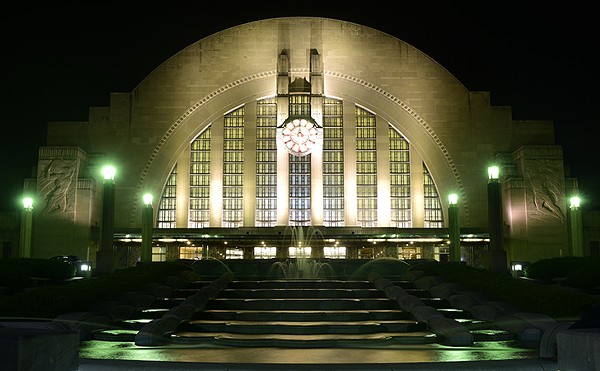More than a few mouths fell open when it was announced that Kristen Stewart had been tapped to play Joan Jett in The Runaways, a biopic about the pioneering all-girl Punk/Metal group’s rapid rise and debauchery-fueled fall in the late 1970s.
Really? The dopey, perpetually lovelorn girl from Twilight is going to play the leather-clad, guitar-slinging, rules-busting bad-ass who is still kicking 30 years later? Add to that the casting of precocious, family-friendly child actress Dakota Fanning as the group’s drug-damaged “Cherry Bomb” singer Cherie Currie, and all signs pointed to The Runaways being just another marketing-driven Hollywood mess.
Not so fast.
Writer/director Floria Sigismondi — an accomplished photographer who's made distinctive videos for the likes of David Bowie, Marilyn Manson, Sigur Ros, Tricky and The White Stripes — generates genuine feeling by centering the narrative on the relationship between Jett and Currie, a then-15-year-old girl who wasn’t ready for the music-biz fast lane. (The movie is based on Currie’s 1989 autobiography, Neon Angel.)
And while The Runaways falls prey to Rock movie cliché from time to time — the scenes in which the band’s charismatic puppet-master Kim Fowley (played with gonzo gusto by Michael Shannon) trains the band for its initial live gigs probably looked better on paper — Sigismondi effectively conveys, through various sensory-enveloping cinematic techniques and the two leads’ credible performances, the raw, confusing emotions of young people searching for their place in the world.
CityBeat recently connected with Sigismondi to discuss everything from the fuss around the casting of Stewart and Fanning to the movie’s teen-angst subject matter.
CityBeat: Why where you interested in telling The Runaways story in film form?
Floria Sigismondi: I was really captivated by how young these girls were and what they went through and stood for — kind of wanting to make Rock music, which girls hadn’t done in that capacity before. They were up to the challenges that all that was going to bring. I was drawn to that.
And something about the arc of Cherie’s story really resonated with me. In the first couple of scenes she can’t say the provocative words that Kim (Fowley) is feeding to her, and by the end she becomes the “Cherry Bomb,” she owns those words. That transformation intrigued me, as did Joan’s inspirational story. There were a lot of things that made it exciting. And it’s Rock & Roll (laughs).
CB: There’s an interesting contradiction at the center of the film: They were these trailblazing girls, but they also had this guy in the background kind of controlling things.
FS: Well, he’s much older than them. They were running around with no parental supervision. Joan had this dream of doing this all-girl band, but he was actually able to put it together. They shared the same goals, especially him and Joan. It would have been extremely difficult to do it without him, because of their age and no one was taking them seriously.
They needed him, even though at times he was abusive and kind of strange in the way that he treated them. They needed someone like him to put them out there, to create the hype, to have people pay attention. You can look at it many different ways. The girls owned their sexuality, but then he was selling them like sex kittens, and that really bothered them. So there was this constant duality and conflict going on between what he wanted and what they wanted.
CB: Can you talk about tackling a true story and trying to transcend the idea of doing a point-to-point regurgitation of events? How did you go about trying to make this your own take on their story?
FS: For me it was trying to get to the essence of the truth. How I deal with the different themes is going to be influenced by how I interpret their story, obviously. It’s about these two girls coming together at that time. They had already made a documentary. I never wanted to make a movie about all the gigs that they played and the factual aspects. For me it was, “What was it like to be 15 years old in this situation and watching it sort of spin out of control.” That was really important to me — to get the rawness, the youth and the essence of the truth.
CB: You did a nice job of conveying what they were feeling through this kind of dreamy, sensory-enveloping visual approach, which was enhanced by the use of music and the set design. Was it important to you to capture that kind of feeling through purely sensual means?
FS: Yes, definitely. It’s funny you mention that. It was very important. Kids at that age — 15 years old — don’t talk about their feelings. They’re insecure. We’ve all been there. Kind of creating your identity: Is it cool to say this? Is it cool to say that? A lot of the communication happens either with looks or with mannerisms. Maybe it’s because I was also a very quiet child, but I always paid attention to the physical, uh, what’s that word I’m looking for? Not physical dialogue…
CB: Body language?
FS: That’s it! Body language! I’ve always been very intrigued by body language, and so I wanted to make a more intuitive film about what these girls where feeling on a deep level.
CB: Well, that’s interesting because some people have criticized the film for being too surface-oriented. But, to me, that’s kind of who The Runaways were at that time.
FS: If you listen to their lyrics, that’s who they were. Joan would always say that to me: “Listen to the lyrics, that’s who I was.” For me, it was about dissecting those lyrics. It was a very physical time period. Music was physical. It was all about experimentation.
These girls were basically singing about what they were experiencing at an age when it’s all about identity. That’s what the picture tries to capture. It was, “I want this and I want that” and feeling a certain way and “come into my room.” It was really about teenage angst and trying to figure out things about your body (laughs).
CB: There seemed to be a Larry Clark-esque thing going on in the way the film was shot and some of the set design. I’m thinking more about his earlier work as a photographer, which often focused on teenage kids doing decadent things in kind of skuzzy locations, than his movies, which often deal with similar subject matter. Was he someone that influenced you?
FS: I come from a photography background, so I come from that visual language. I love his work in Tulsa (Clark’s 1971 photo book), but I was creating this stuff from scratch. It was important to me to get the authentic look and feel of the ’70s. It was important that the girls be able to play their instruments.
I kind of wanted to take the Hollywood gloss off of everything and kind of create pimples and bed head and smoking up all the environments. I shot on Super 16, so all that was very important to me. My own photography work has a sort of rawness to it. I’ve always been drawn to imperfections and mistakes. It was very important for me to get the old lenses that actually allow for flares to give it an edgier feeling. That’s kind of my natural aesthetic.
CB: The film has gotten a lot of attention for what some people have called its “stunt casting.” Dakota Fanning was a curious choice, but I read that you cast Kristen Stewart before all the Twilight craziness. Can you talk about why you wanted those two in the film?
FS: Art Linson, one of our producers on the film, had just finished Into the Wild, Sean Penn’s movie with Kristen, and said, “You really need to meet this girl.” When I met her I was kind of taken aback, because I had seen the film and she was quite captivating in the sort amount of time she was on screen. I was really taken by her, especially her eyes, how she emoted with her eyes. That kind of communication is very important to me. The same with Dakota — she’s another girl with eyes (laughs).
When I met Kristen there was this unique quality about her. She was shy, but there was this duality in her that I saw in Joan when I met her. So I thought she’d be perfect. She played the guitar and sang. We inked her deal the day Twilight came out. I had no idea about the hoopla that movie was going to cause.
And Dakota, I was surprised when I found out she was interested. We weren’t thinking about her, because when I was writing the script she was too young. But when she came in for the casting she was 14 — she was 15 when we shot — and not only was she incredibly talented but was now the right age. It just felt right to me.
THE RUNAWAYS opens April 9. Read tt stern-enzi's review here.





